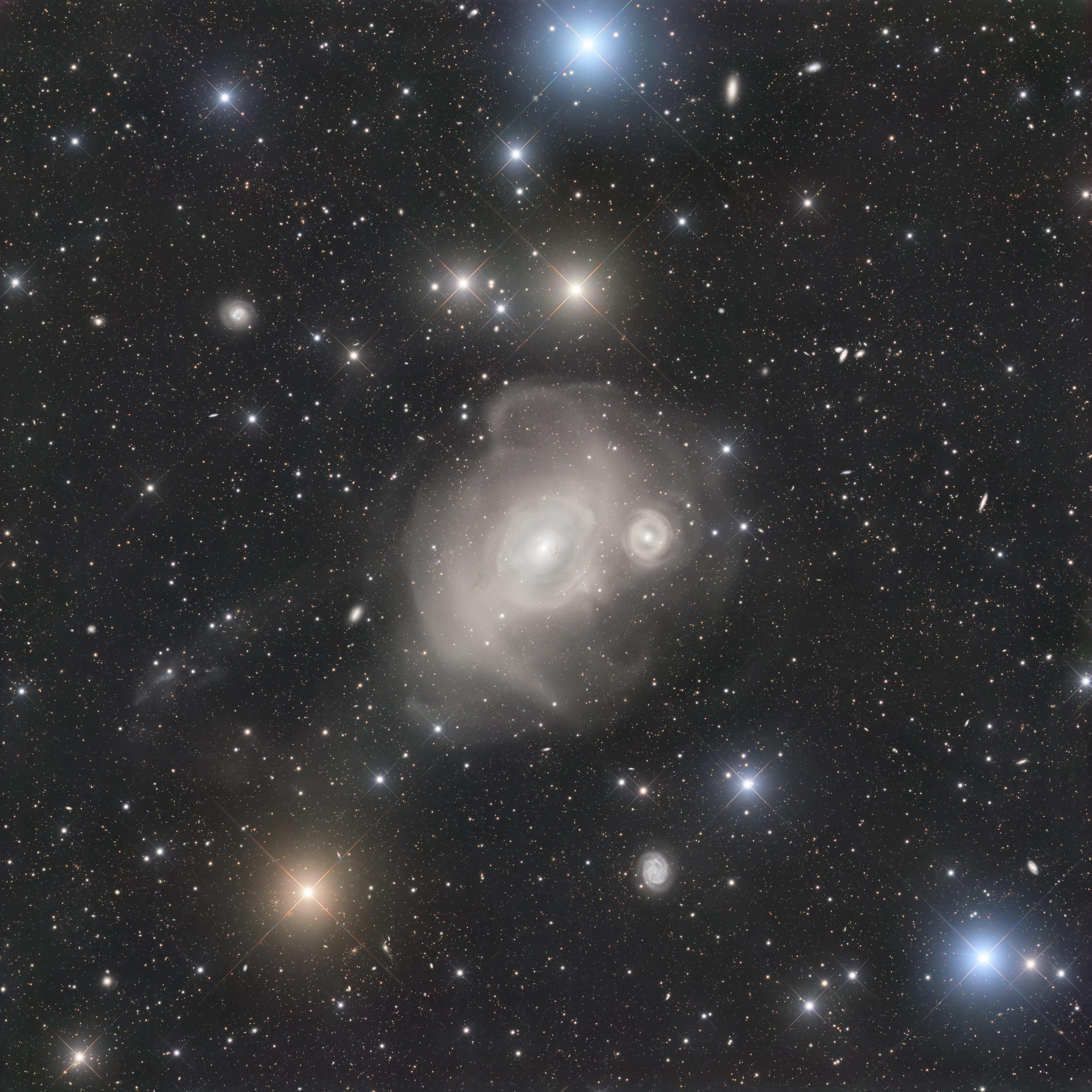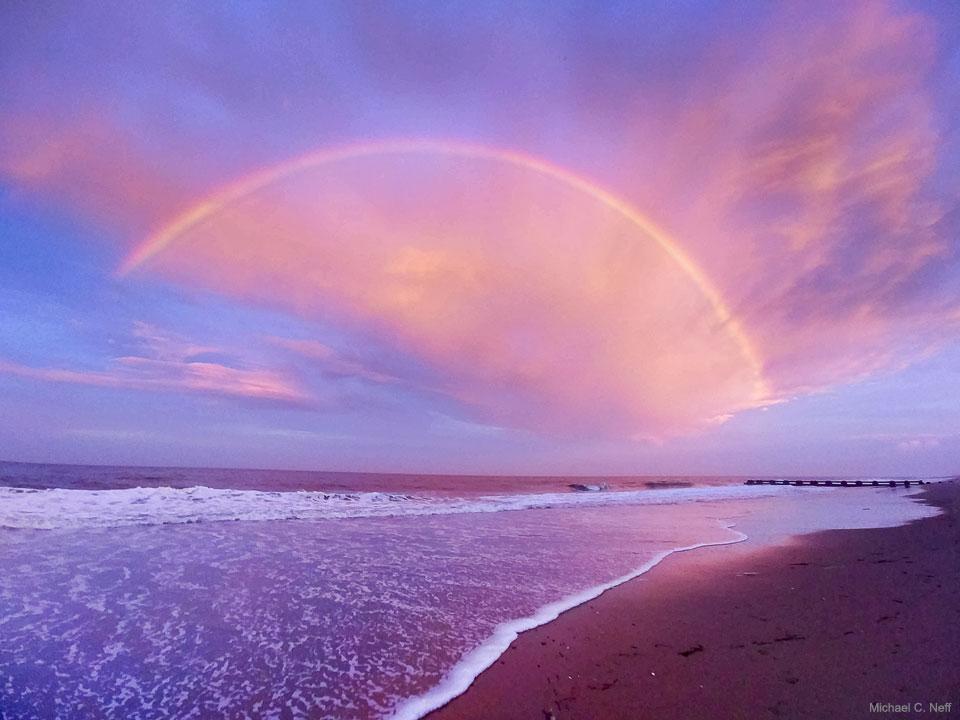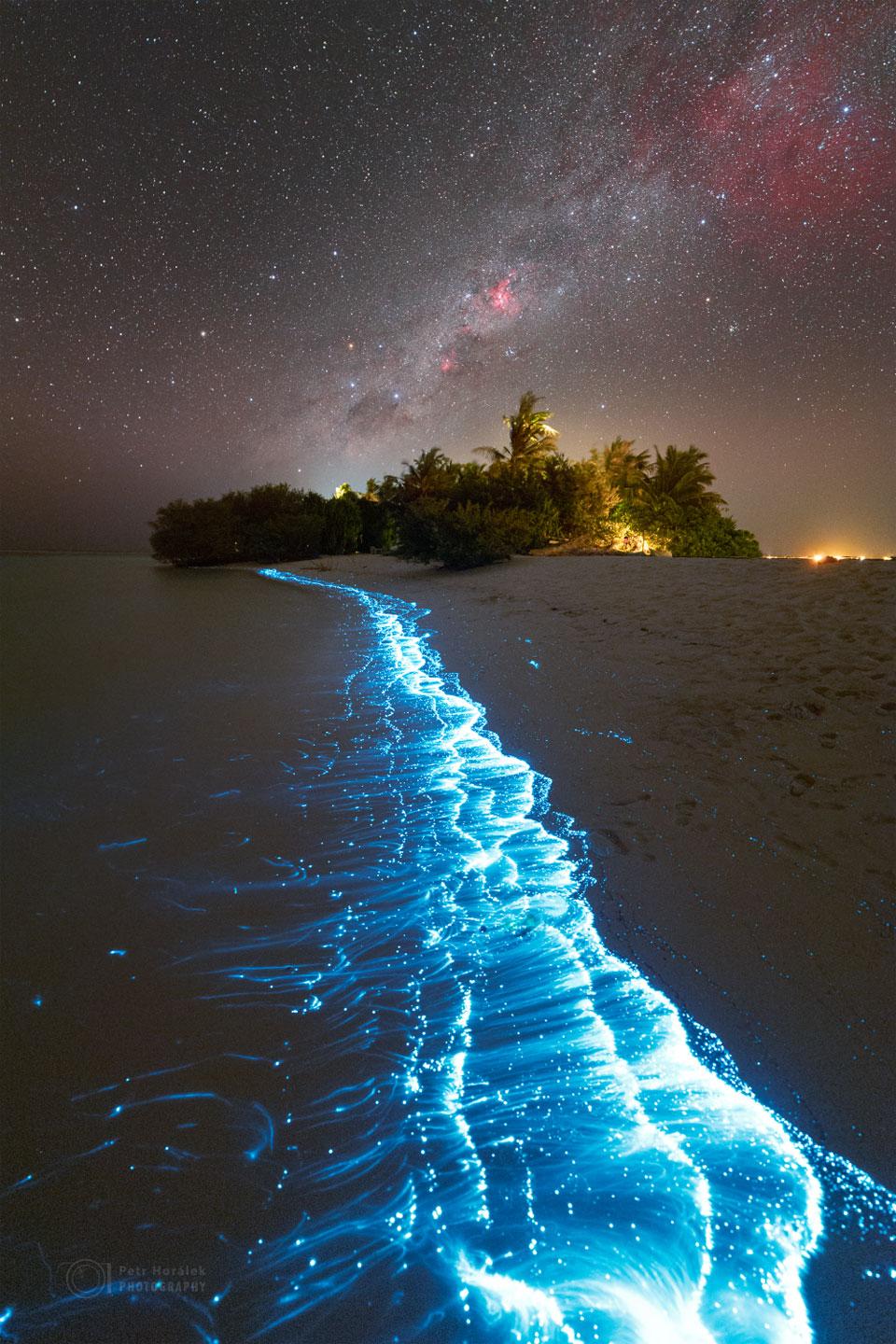Galaxies in the Furnace https://apod.nasa.gov/apod/ap251204.html #APOD
Visualization: Near a Black Hole and Disk
Illustration Credit: NASA's GSFC, J. Schnittman & B. Powell; Text: Francis Reddy (U. Maryland, NASA's GSFC)
Explanation: What would it look like to plunge into a monster black hole? This image from a supercomputer visualization shows the entire sky as seen from a simulated camera plunging toward a 4-million-solar-mass black hole, similar to the one at the center of our galaxy. The camera lies about 16 million kilometers from the black hole’s event horizon and is moving inward at 62% the speed of light. Thanks to gravity’s funhouse effects, the starry band of the Milky Way appears both as a compact loop at the top of this view and as a secondary image stretching across the bottom. Move the cursor over the image for additional explanations. Visualizations like this allow astronomers to explore black holes in ways not otherwise possible.
Visualization: Near a Black Hole and Disk
Illustration Credit: NASA's GSFC, J. Schnittman & B. Powell; Text: Francis Reddy (U. Maryland, NASA's GSFC)
Explanation: What would it look like to plunge into a monster black hole? This image from a supercomputer visualization shows the entire sky as seen from a simulated camera plunging toward a 4-million-solar-mass black hole, similar to the one at the center of our galaxy. The camera lies about 16 million kilometers from the black hole’s event horizon and is moving inward at 62% the speed of light. Thanks to gravity’s funhouse effects, the starry band of the Milky Way appears both as a compact loop at the top of this view and as a secondary image stretching across the bottom. Move the cursor over the image for additional explanations. Visualizations like this allow astronomers to explore black holes in ways not otherwise possible.
Galaxies in the Furnace https://apod.nasa.gov/apod/ap251204.html #APOD
Comet Lemmon and the Milky Way
Image Credit & Copyright: Lin Zixuan (Tsinghua U.)
Explanation: What did Comet Lemmon look like when it was at its best? One example is pictured here, featuring three celestial spectacles all at different distances. The closest spectacle is the snowcapped Meili Mountains, part of the Himalayas in China. The middle marvel is Comet Lemmon near its picturesque best early this month, showing not only a white dust tail trailing off to the right but its blue solar wind-distorted ion tail trailing off to the left. Far in the distance on the left is the magnificent central plane of our Milky Way Galaxy, featuring dark dust, red nebula, and including billions of Sun-like stars. Comet C/2025 A6 (Lemmon) is already fading as it heads back into the outer Solar System, while the Himalayan mountains will gradually erode over the next billion years. The Milky Way Galaxy, though, will live on -- forming new mountains and comets -- for many billions of years into the future.
Comet Lemmon and the Milky Way
Image Credit & Copyright: Lin Zixuan (Tsinghua U.)
Explanation: What did Comet Lemmon look like when it was at its best? One example is pictured here, featuring three celestial spectacles all at different distances. The closest spectacle is the snowcapped Meili Mountains, part of the Himalayas in China. The middle marvel is Comet Lemmon near its picturesque best early this month, showing not only a white dust tail trailing off to the right but its blue solar wind-distorted ion tail trailing off to the left. Far in the distance on the left is the magnificent central plane of our Milky Way Galaxy, featuring dark dust, red nebula, and including billions of Sun-like stars. Comet C/2025 A6 (Lemmon) is already fading as it heads back into the outer Solar System, while the Himalayan mountains will gradually erode over the next billion years. The Milky Way Galaxy, though, will live on -- forming new mountains and comets -- for many billions of years into the future.
Apep: Unusual Dust Shells from Webb
Image Credit: NASA, ESA, CSA, STScI, JWST; Science: Y. Han (Caltech), R. White (Macquarie U.); Image Processing: A. Pagan (STScI)
Explanation: What created this unusual space sculpture? Stars. This unusual system of swirls and shells, known as Apep, was observed in unprecedented detail by NASA’s James Webb Space Telescope in infrared light in 2024. Observations indicate that the unusual shape originates from two massive Wolf-Rayet stars orbiting each other every 190 years with each close passes causing a new shell of dust and gas to be expelled. Holes in these shells are thought to be caused by a third orbiting star. This stellar dust dance will likely continue for hundreds of thousands of years, possibly ending only when one of the massive stars runs out of internal nuclear fuel and explodes in a supernova punctuated by a burst of gamma-rays.
Build your own star system: Astronomy Puzzle of the Day
Apep: Unusual Dust Shells from Webb
Image Credit: NASA, ESA, CSA, STScI, JWST; Science: Y. Han (Caltech), R. White (Macquarie U.); Image Processing: A. Pagan (STScI)
Explanation: What created this unusual space sculpture? Stars. This unusual system of swirls and shells, known as Apep, was observed in unprecedented detail by NASA’s James Webb Space Telescope in infrared light in 2024. Observations indicate that the unusual shape originates from two massive Wolf-Rayet stars orbiting each other every 190 years with each close passes causing a new shell of dust and gas to be expelled. Holes in these shells are thought to be caused by a third orbiting star. This stellar dust dance will likely continue for hundreds of thousands of years, possibly ending only when one of the massive stars runs out of internal nuclear fuel and explodes in a supernova punctuated by a burst of gamma-rays.
Build your own star system: Astronomy Puzzle of the Day
2025 November 20
Alnitak, Alnilam, Mintaka
* Image Credit & Copyright: Aygen Erkaslan
https://app.astrobin.com/u/a.erkaslan#gallery
Explanation:
Alnitak, Alnilam, and Mintaka are the bright bluish stars from east to west (upper right to lower left) along the diagonal in this cosmic vista. Otherwise known as the Belt of Orion, these three blue supergiant stars are hotter and much more massive than the Sun. They lie from 700 to 2,000 light-years away, born of Orion's well-studied interstellar clouds. In fact, clouds of gas and dust adrift in this region have some surprisingly familiar shapes, including the dark Horsehead Nebula and Flame Nebula near Alnitak at the upper right. The famous Orion Nebula itself is off the right edge of this colorful starfield. The telescopic frame spans almost 4 degrees on the sky.
http://stars.astro.illinois.edu/sow/alnitak.html
http://stars.astro.illinois.edu/sow/alnilam.html
http://stars.astro.illinois.edu/sow/mintaka.html
https://app.astrobin.com/u/a.erkaslan?i=6igdue#gallery
https://www.gb.nrao.edu/~rmaddale/Education/OrionTourCenter/optical.html
https://apod.nasa.gov/apod/ap200919.html
https://apod.nasa.gov/apod/ap250902.html
https://apod.nasa.gov/apod/ap251113.html
https://apod.nasa.gov/apod/ap120119.html
https://apod.nasa.gov/apod/ap251120.html
#space #nebula #astronomy #science #astrophotography #photography #nature #nebula #NASA #apod
2025 November 20
Alnitak, Alnilam, Mintaka
* Image Credit & Copyright: Aygen Erkaslan
https://app.astrobin.com/u/a.erkaslan#gallery
Explanation:
Alnitak, Alnilam, and Mintaka are the bright bluish stars from east to west (upper right to lower left) along the diagonal in this cosmic vista. Otherwise known as the Belt of Orion, these three blue supergiant stars are hotter and much more massive than the Sun. They lie from 700 to 2,000 light-years away, born of Orion's well-studied interstellar clouds. In fact, clouds of gas and dust adrift in this region have some surprisingly familiar shapes, including the dark Horsehead Nebula and Flame Nebula near Alnitak at the upper right. The famous Orion Nebula itself is off the right edge of this colorful starfield. The telescopic frame spans almost 4 degrees on the sky.
http://stars.astro.illinois.edu/sow/alnitak.html
http://stars.astro.illinois.edu/sow/alnilam.html
http://stars.astro.illinois.edu/sow/mintaka.html
https://app.astrobin.com/u/a.erkaslan?i=6igdue#gallery
https://www.gb.nrao.edu/~rmaddale/Education/OrionTourCenter/optical.html
https://apod.nasa.gov/apod/ap200919.html
https://apod.nasa.gov/apod/ap250902.html
https://apod.nasa.gov/apod/ap251113.html
https://apod.nasa.gov/apod/ap120119.html
https://apod.nasa.gov/apod/ap251120.html
#space #nebula #astronomy #science #astrophotography #photography #nature #nebula #NASA #apod
Annotated Hi-Res image for previews post.
Chamaeleon Dark Nebulas
* Image Credit & Copyright: Xinran Li & Houbo Zhou
https://apod.nasa.gov/apod/fap/ap251119.html
#space #nebula #astronomy #science #astrophotography #photography #nature #nebula #NASA #apod
2025 November 19
Chamaeleon Dark Nebulas
* Image Credit & Copyright: Xinran Li & Houbo Zhou
https://app.astrobin.com/u/Flying_Dutchman#gallery
Explanation:
Sometimes the dark dust of interstellar space has an angular elegance. Such is the case toward the far-south constellation of Chamaeleon. Normally too faint to see, dark dust is best known for blocking visible light from stars and galaxies behind it. In this 11.4-hour exposure, however, the dust is seen mostly in light of its own, with its strong red and near-infrared colors creating a brown hue. Contrastingly blue, a bright star Beta Chamaeleontis is visible on the upper right of the V, with the dust that surrounds it preferentially reflecting blue light from its primarily blue-white color. All of the pictured stars and dust occur in our own Milky Way Galaxy with one notable exception: a white spot just below Beta Chamaeleontis is the galaxy IC 3104 which lies far in the distance. Interstellar dust is mostly created in the cool atmospheres of giant stars and dispersed into space by stellar light, stellar winds, and stellar explosions such as supernovas.
https://en.wikipedia.org/wiki/Chamaeleon
https://en.wikipedia.org/wiki/Beta_Chamaeleontis
https://www.flickr.com/photos/hiroc/47807534932
http://www.werbeagentur.org/oldwexi/gallery.html
https://theskylive.com/sky/deepsky/ic3104-object
https://apod.nasa.gov/apod/ap180628.html
https://www.science.org/content/article/interstellar-dust-may-come-supernovae-after-all
https://en.wikipedia.org/wiki/List_of_stellar_explosion_types
https://en.wikipedia.org/wiki/Red_giant
https://astronomy.swin.edu.au/cosmos/d/Dust+Grain
https://apod.nasa.gov/apod/ap000318.html
https://science.nasa.gov/ems/07_infraredwaves/
https://apod.nasa.gov/apod/ap251119.html
#space #nebula #astronomy #science #astrophotography #photography #nature #nebula #NASA #apod
Comet Lemmon's Wandering Tail
Image Credit: Ignacio Fernández
Explanation: What has happened to Comet Lemmon's tail? The answer is blowing in the wind — the wind from the Sun in this case. This continuous outflow of charged particles from the Sun has been quite variable of late, as the Sun emits bursts of energy, CMEs, that push out and deflect charged particles emitted by the comet itself. The result is a blue hued ion tail for Comet C/2025 A6 (Lemmon) that is not only impressively intricate but takes some unusual turns. This long-duration composite image taken from Alfacar, Spain last month captured this inner Solar System ionic tumult. Comet Lemmon is now fading as it heads out away from the Earth and Sun and back into the outer Solar System.
Comet Lemmon's Wandering Tail
Image Credit: Ignacio Fernández
Explanation: What has happened to Comet Lemmon's tail? The answer is blowing in the wind — the wind from the Sun in this case. This continuous outflow of charged particles from the Sun has been quite variable of late, as the Sun emits bursts of energy, CMEs, that push out and deflect charged particles emitted by the comet itself. The result is a blue hued ion tail for Comet C/2025 A6 (Lemmon) that is not only impressively intricate but takes some unusual turns. This long-duration composite image taken from Alfacar, Spain last month captured this inner Solar System ionic tumult. Comet Lemmon is now fading as it heads out away from the Earth and Sun and back into the outer Solar System.
Red Cloudbow over Delaware
What kind of rainbow is this? In this case, no rain was involved -- what is pictured is actually a red cloudbow. The unusual sky arc was spotted last month during sunset in Rehoboth Beach, Delaware, USA. When the photographer realized that what he was seeing was extraordinary, he captured it with the only camera available -- a cell phone.
Image Credit & Copyright: Michael C. Neff (Neffworks Artography)
Milky Way over a Turquoise Wonderland
What glows there? The answer depends: sea or sky? In the sea, the unusual blue glow is bioluminescence. Specifically, the glimmer arises from Noctiluca scintillans, single-celled plankton stimulated by the lapping waves. The plankton use their glow to startle and illuminate predators.
#photography
#astrophotography
#MilkyWay
#bioluminescence
#Maldives
#APOD
Red Cloudbow over Delaware
What kind of rainbow is this? In this case, no rain was involved -- what is pictured is actually a red cloudbow. The unusual sky arc was spotted last month during sunset in Rehoboth Beach, Delaware, USA. When the photographer realized that what he was seeing was extraordinary, he captured it with the only camera available -- a cell phone.
Image Credit & Copyright: Michael C. Neff (Neffworks Artography)
Milky Way over a Turquoise Wonderland
What glows there? The answer depends: sea or sky? In the sea, the unusual blue glow is bioluminescence. Specifically, the glimmer arises from Noctiluca scintillans, single-celled plankton stimulated by the lapping waves. The plankton use their glow to startle and illuminate predators.
#photography
#astrophotography
#MilkyWay
#bioluminescence
#Maldives
#APOD
Jupiter in Ultraviolet from Hubble
Image Credit: NASA, ESA, Hubble; Processing & License: Judy Schmidt
Explanation: Jupiter looks a bit different in ultraviolet light. To better interpret Jupiter's cloud motions and to help NASA's robotic Juno spacecraft understand the planetary context of the small fields that it sees, the Hubble Space Telescope was being directed to regularly image the entire Jovian giant. The colors of Jupiter being monitored go beyond the normal human visual range to include both ultraviolet and (not pictured) infrared light. Featured from 2017, Jupiter appears different in near ultraviolet light, partly because the amount of sunlight reflected back is distinct, giving differing cloud heights and latitudes discrepant brightnesses. In the near UV, Jupiter's poles appear relatively dark, as does its Great Red Spot and a smaller (optically) white oval to the right. The String of Pearl storms farther to the right, however, are brightest in near ultraviolet, and so here appear (false-color) pink. Jupiter's largest moon Ganymede appears on the upper left. Juno continues on a looping 33-day orbit around Jupiter, while Earth-orbiting Hubble is aging and now relies on a single stabilizing gyroscope.
Road to the Galactic Center
Image Credit & Copyright: Michael Abramyan
Explanation: Does the road to our galaxy's center go through Monument Valley? It doesn't have to, but if your road does -- take a picture. In this case, the road is US Route 163 and iconic buttes on the Navajo National Reservation populate the horizon. The band of Milky Way Galaxy stretches down from the sky and appears to be a continuation of the road on Earth. Filaments of dust darken the Milky Way, in contrast to billions of bright stars and several colorful glowing gas clouds including the Lagoon and Trifid nebulas. The featured picture is a composite of images taken with the same camera and from the same location -- Forest Gump Point in Utah, USA. The foreground was taken just after sunset in early 2021 September during the blue hour, while the background is a mosaic of four exposures captured a few hours later.















